Abstract
The relationship between paired hookworm prevalence and mean intensity of infection data from geographically defined communities was examined. The results show that, in spite of major socio-economic and environmental differences between communities, the relationship is consistent and non-linear. A generalized value of k (the exponent of the negative binomial distribution) for hookworms was estimated to be 0.34, which is consonant with previous estimates from cross-sectional data. Maximum likelihood analysis indicates that the severity of hookworm aggregation in humans has an inverse relationship to mean worm burden which is less marked than for Ascaris lumbricoides. A simple model, based on published estimates of hookworm burdens associated with hookworm anaemia, was used to predict prevalence of morbidity from prevalence of infection data for Tanzania, Kenya and Zambia. Predictions correspond to the observation that hookworm anaemia is highly focal, and largely coastal, in distribution. These analyses suggest that locality-targeting of chemotherapy is particularly appropriate for the control of hookworm morbidity.
Full text
PDF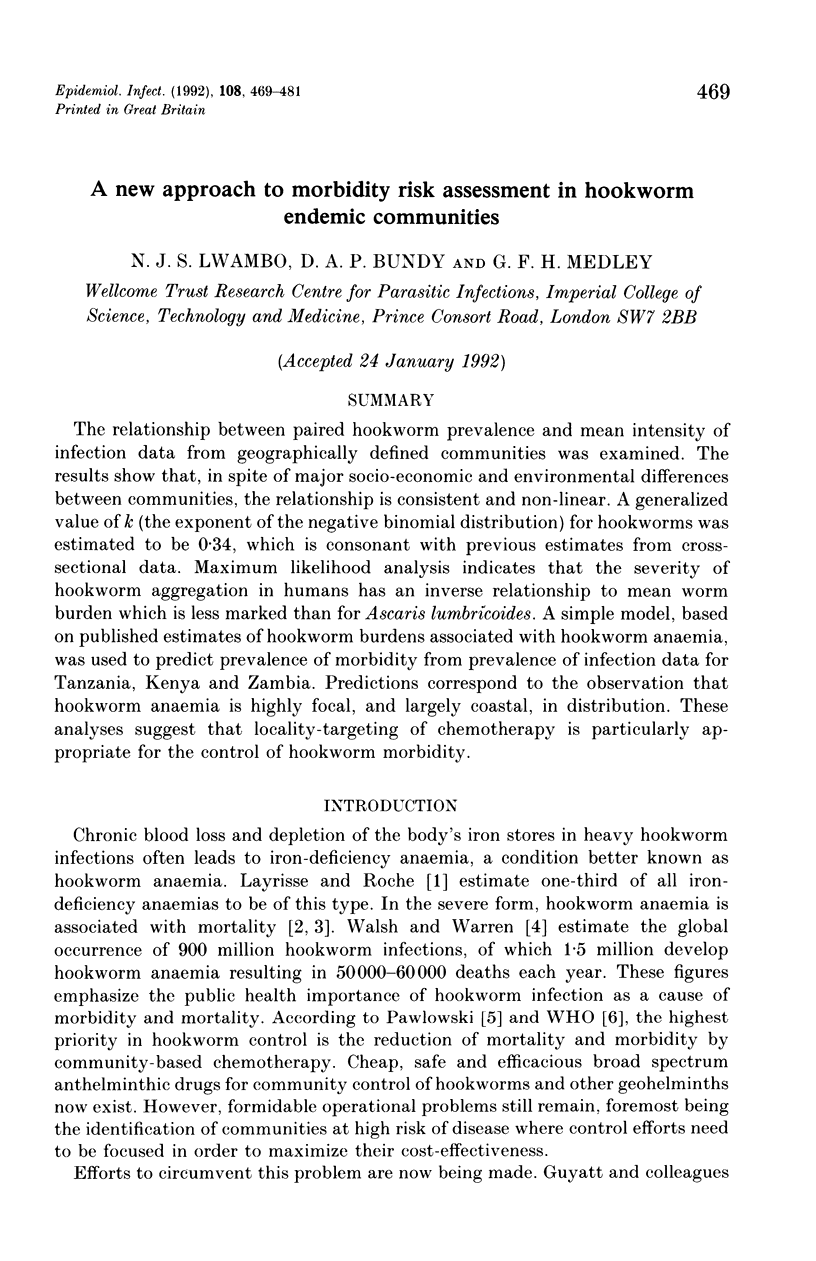
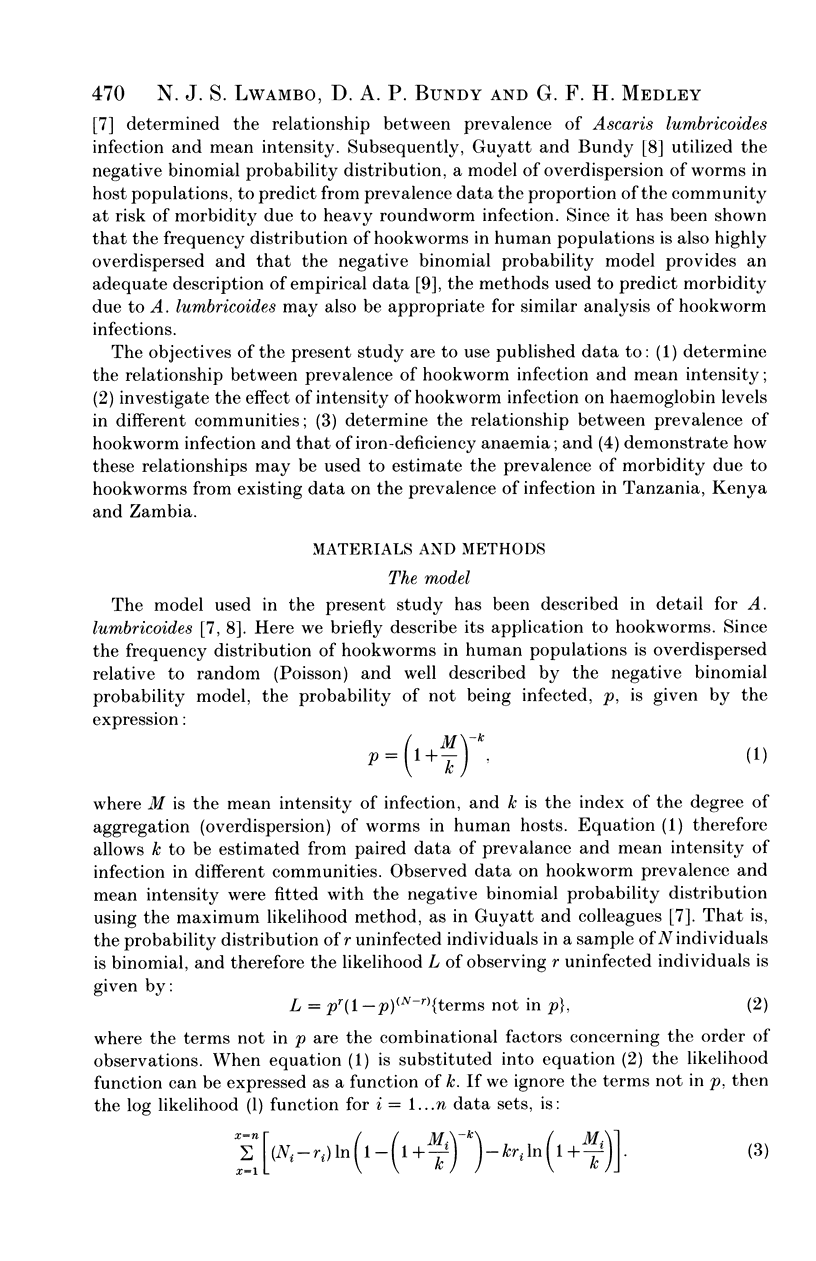
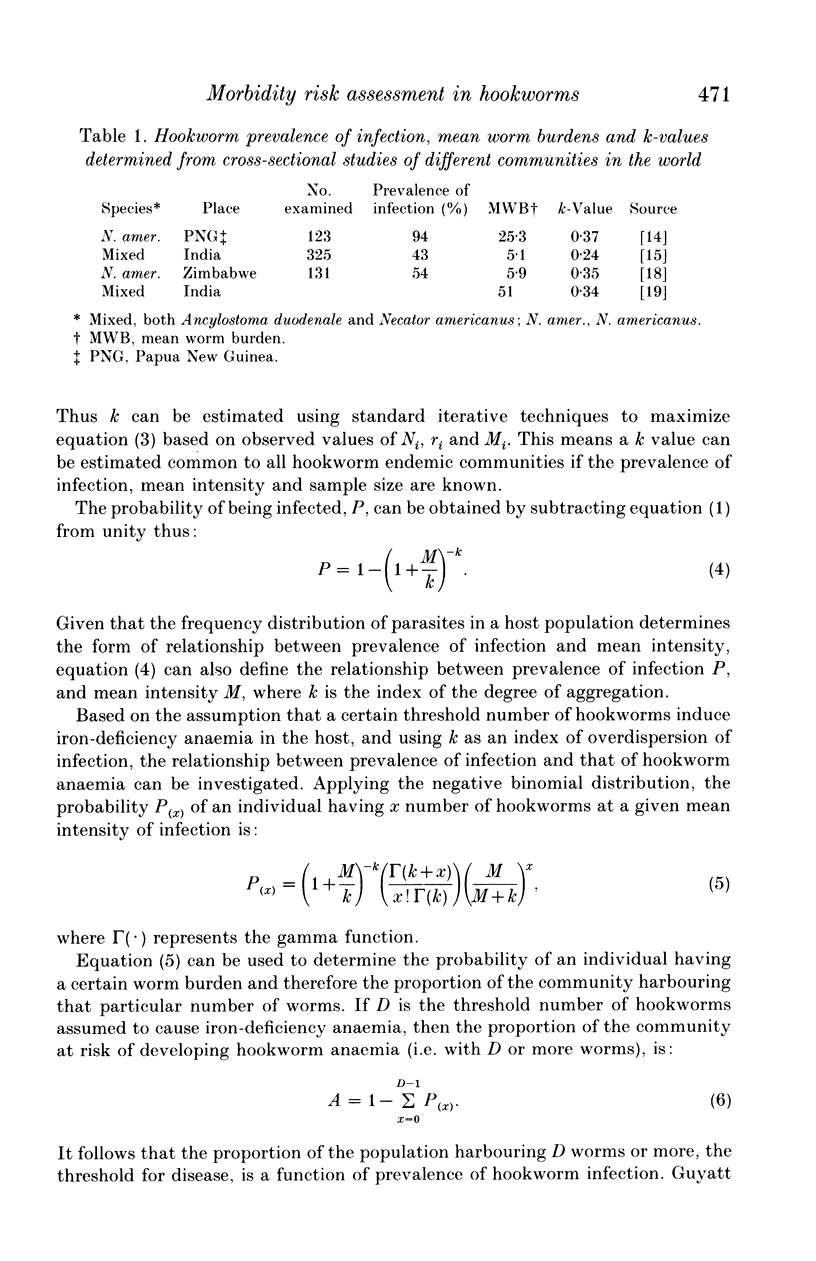
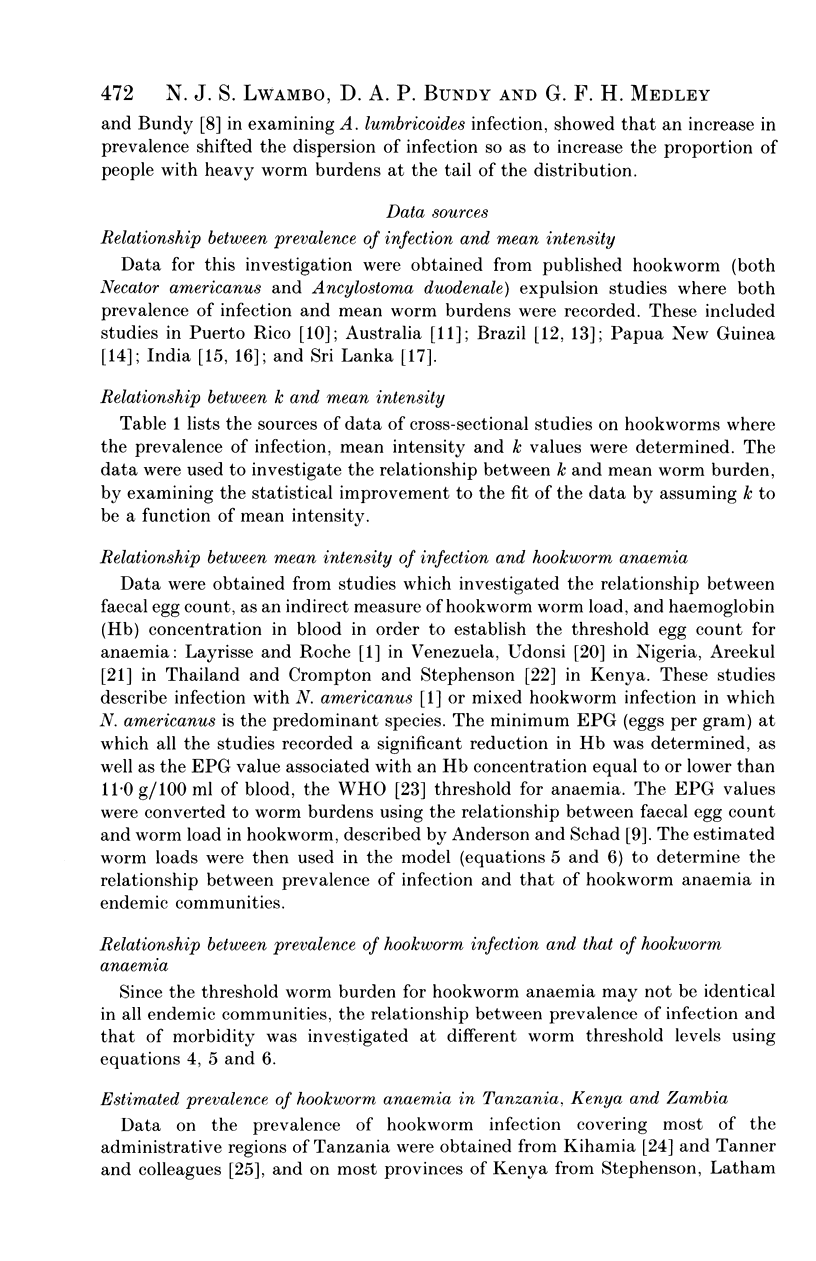
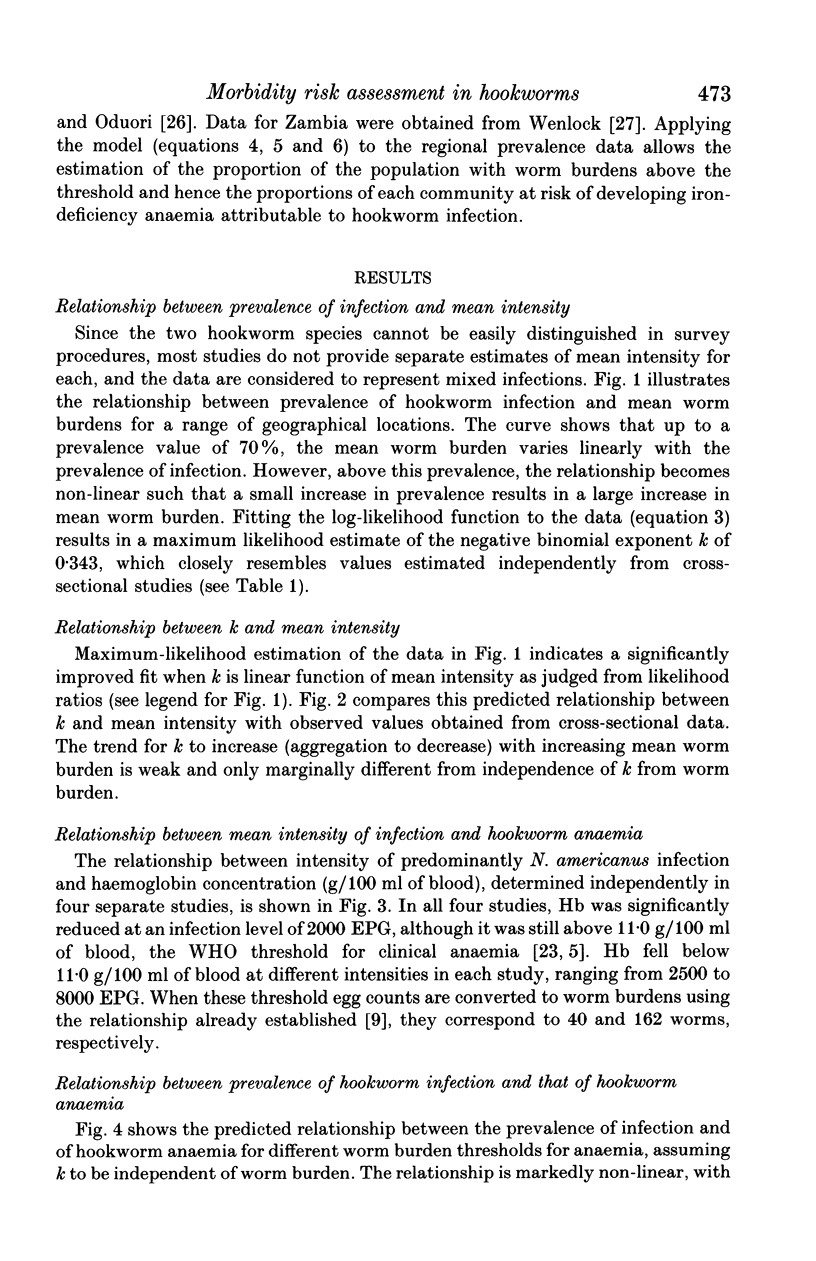
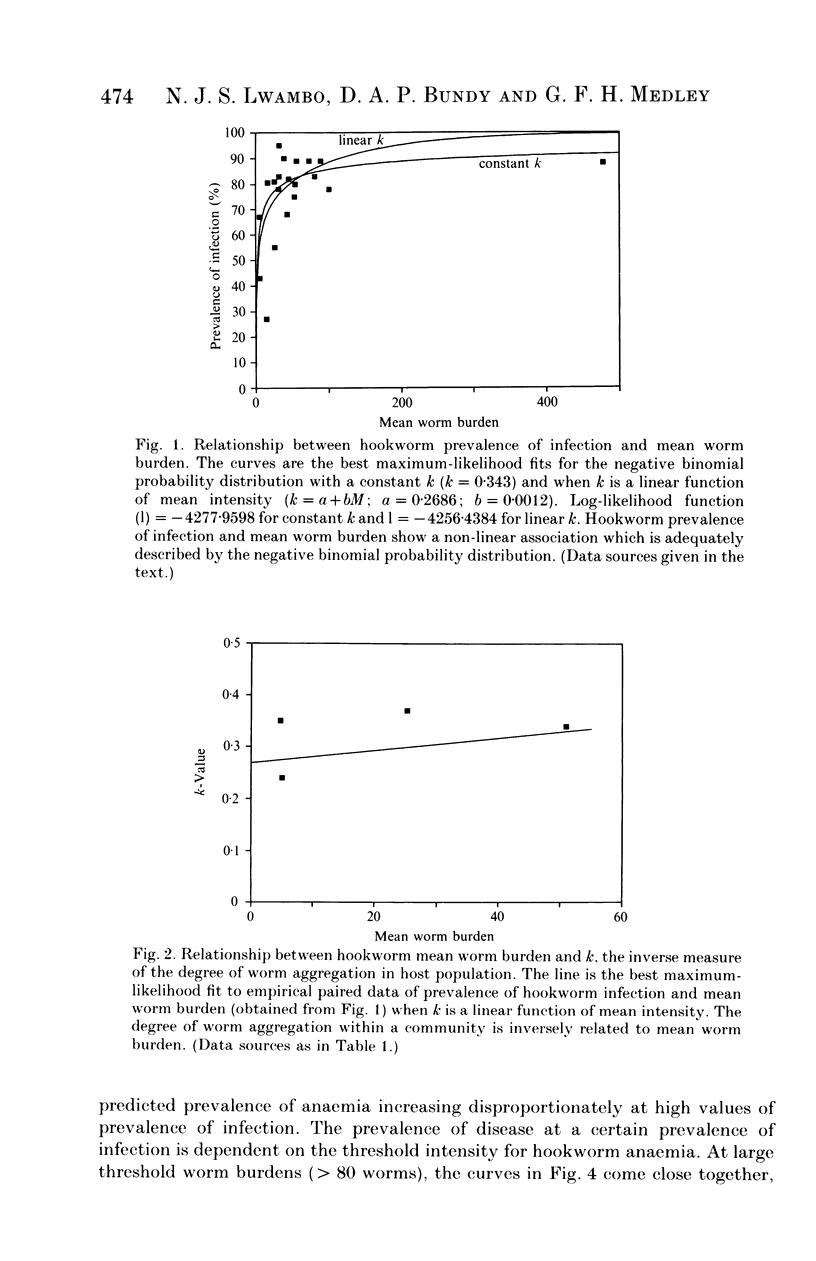
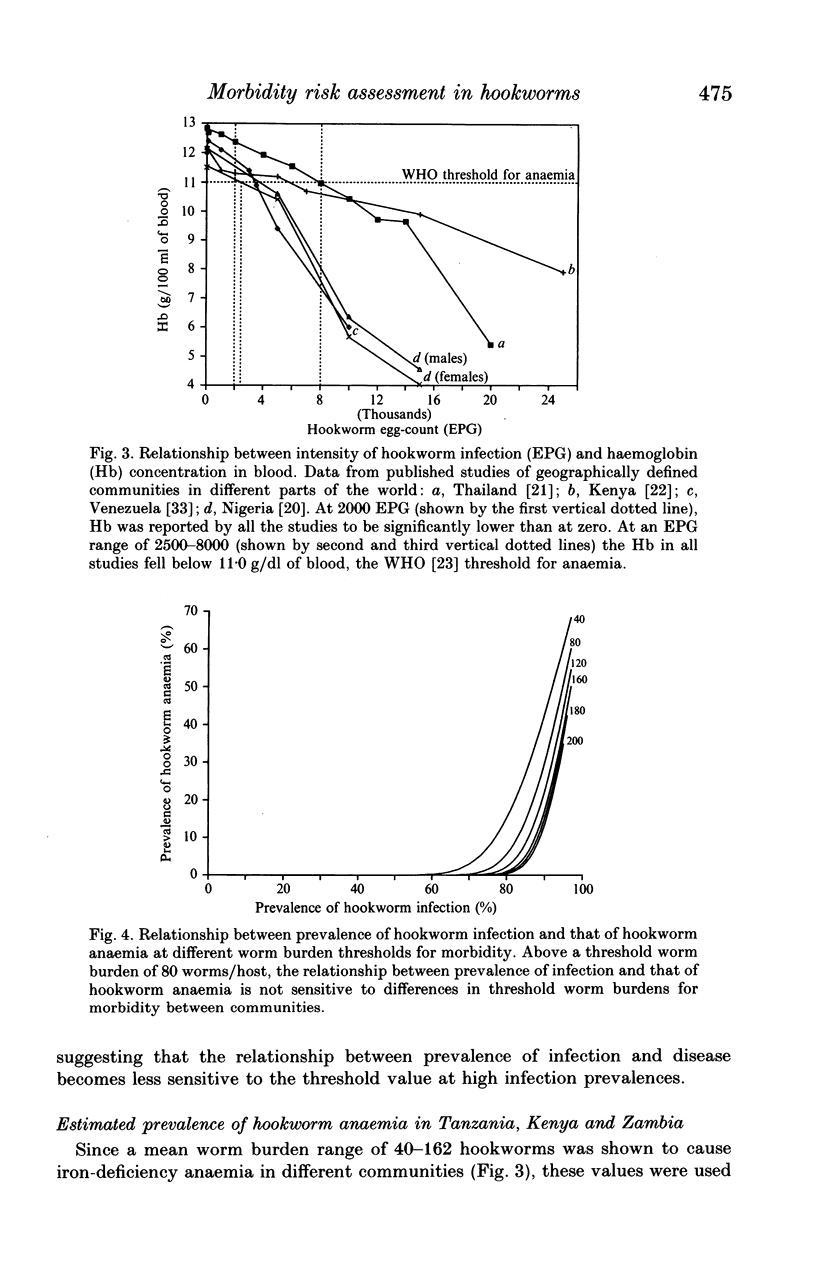
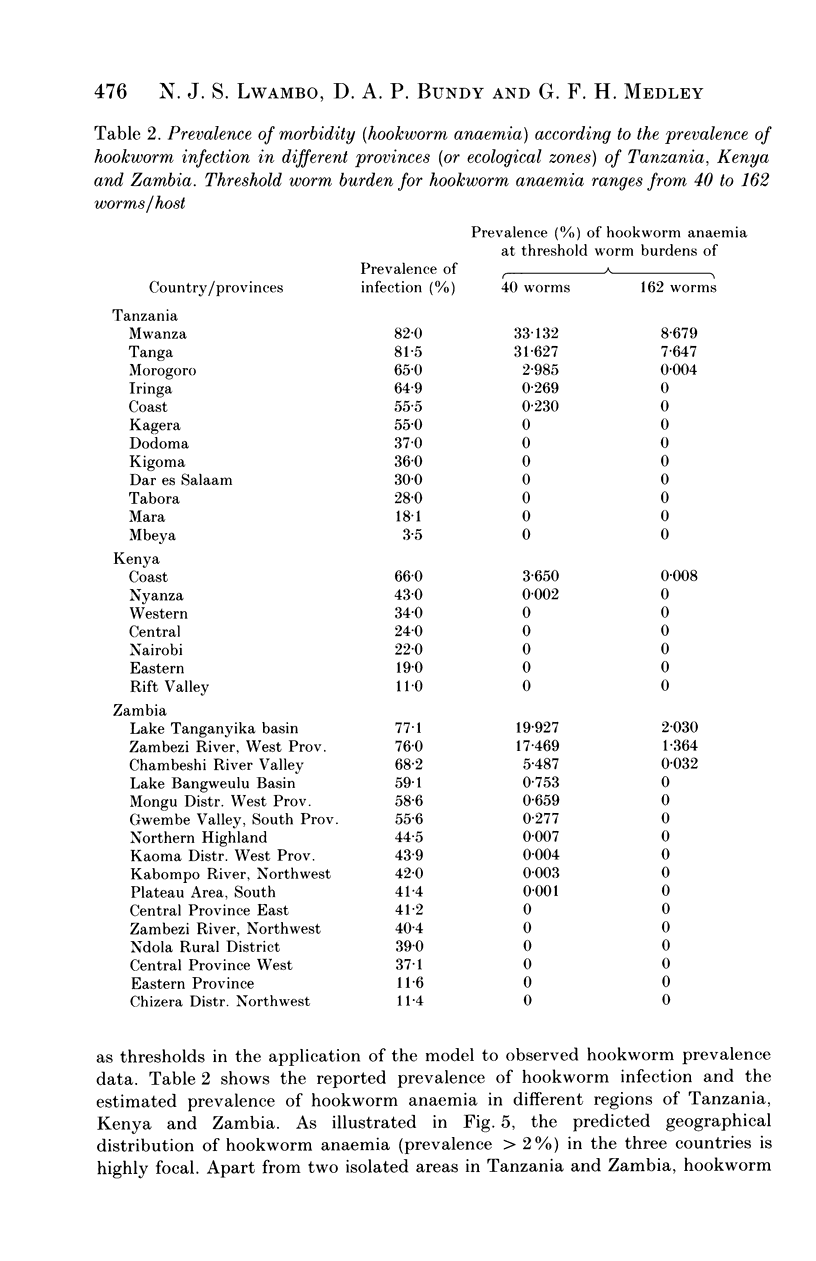
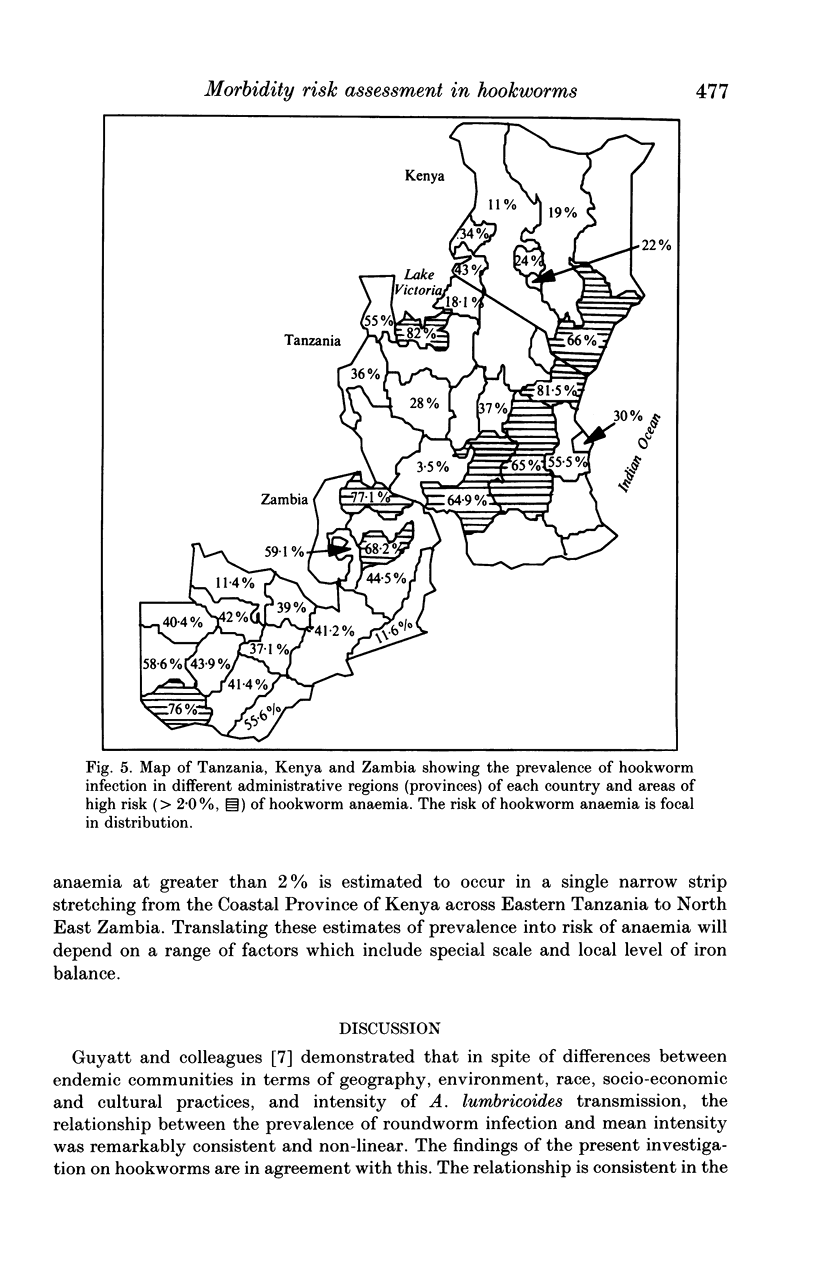

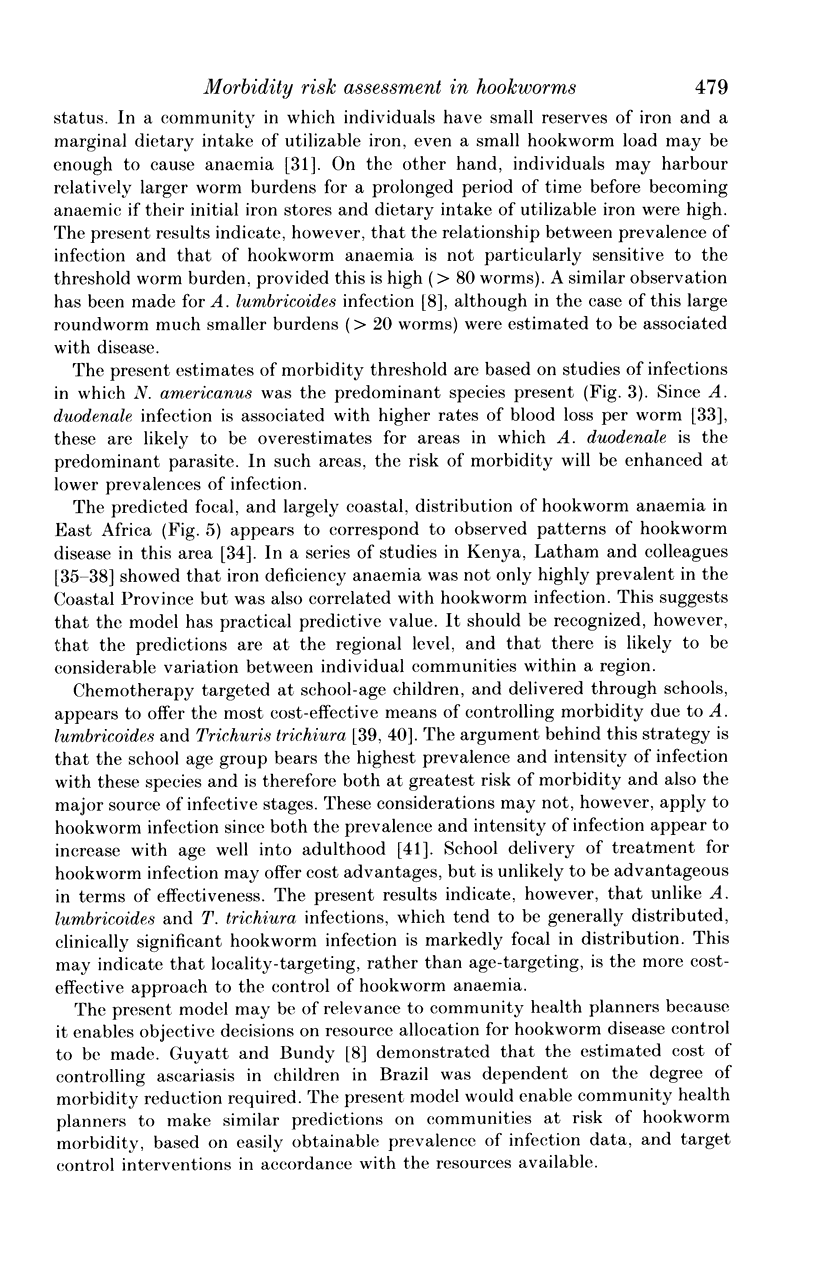
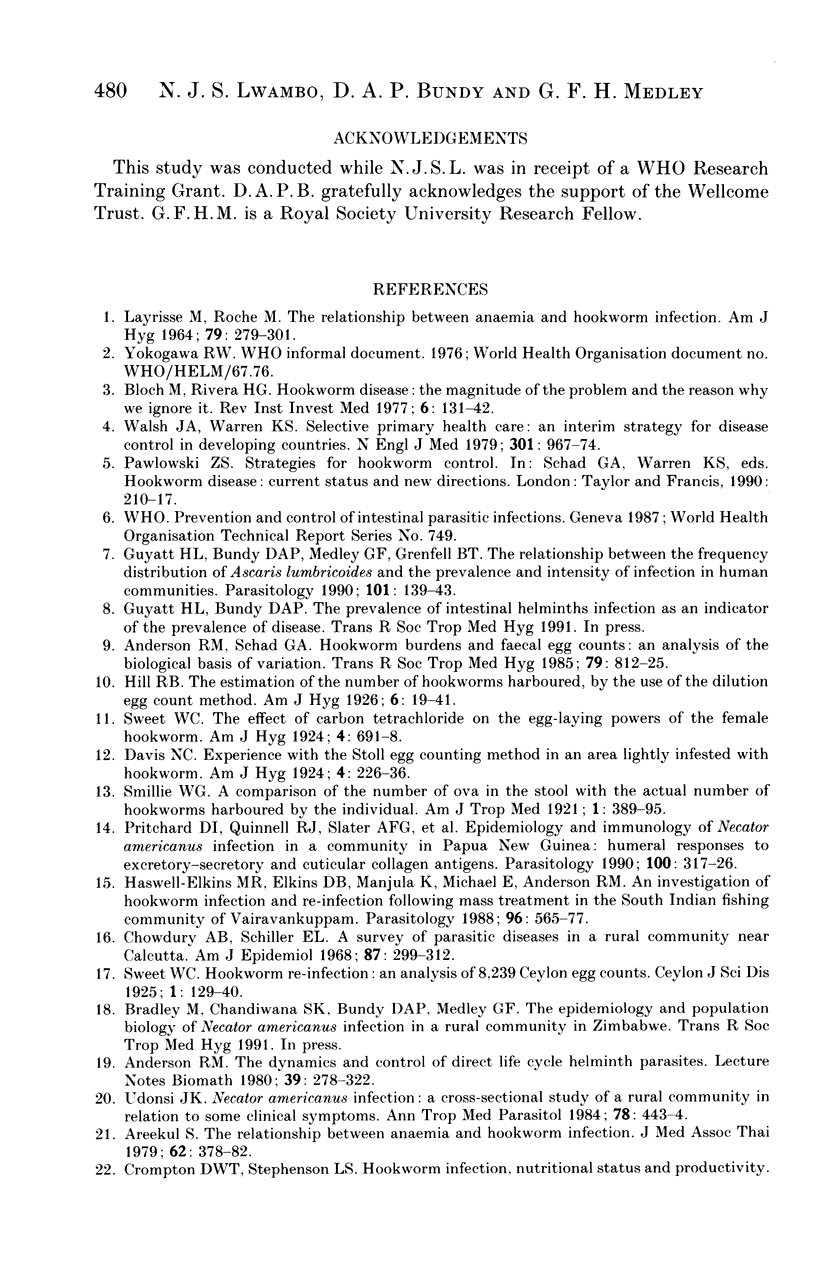
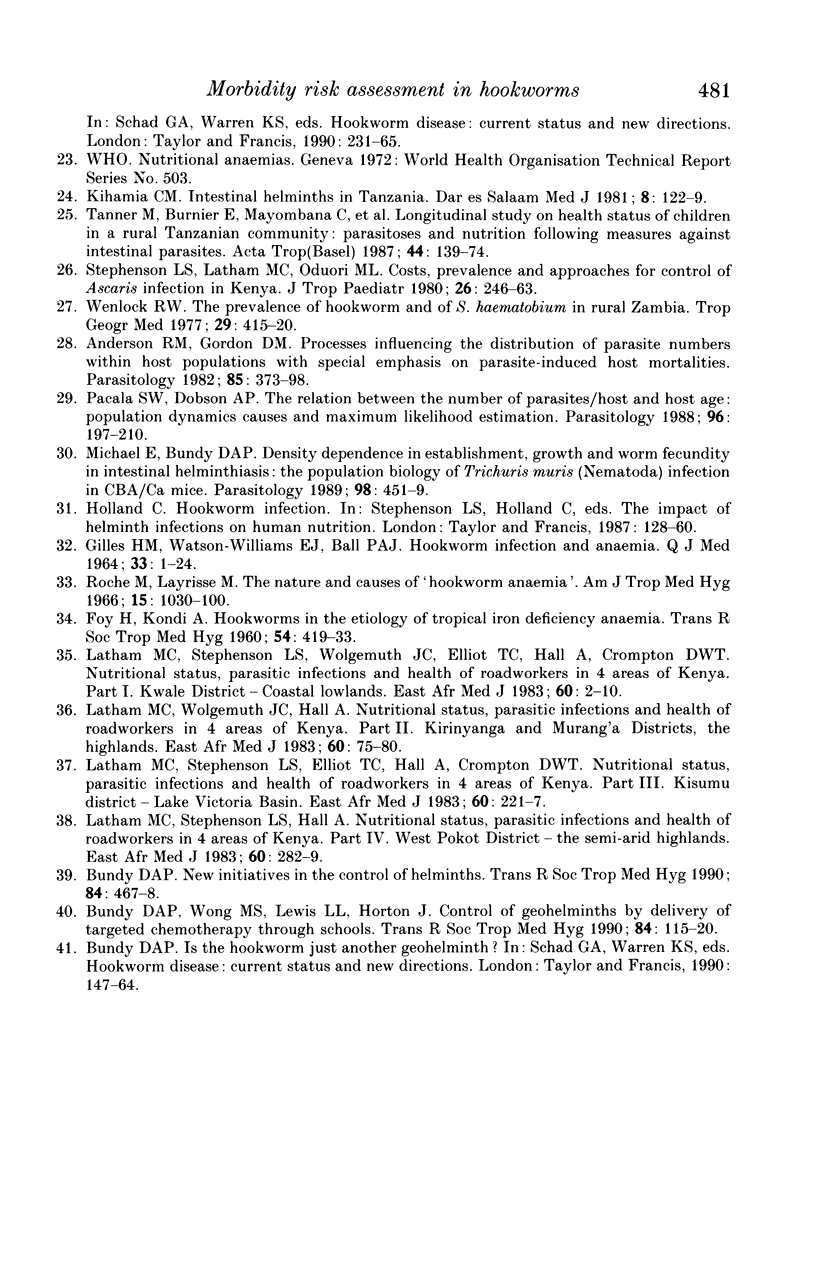
Selected References
These references are in PubMed. This may not be the complete list of references from this article.
- Anderson R. M., Gordon D. M. Processes influencing the distribution of parasite numbers within host populations with special emphasis on parasite-induced host mortalities. Parasitology. 1982 Oct;85(Pt 2):373–398. doi: 10.1017/s0031182000055347. [DOI] [PubMed] [Google Scholar]
- Anderson R. M., Schad G. A. Hookworm burdens and faecal egg counts: an analysis of the biological basis of variation. Trans R Soc Trop Med Hyg. 1985;79(6):812–825. doi: 10.1016/0035-9203(85)90128-2. [DOI] [PubMed] [Google Scholar]
- Bundy D. A. New initiatives in the control of helminths. Trans R Soc Trop Med Hyg. 1990 Jul-Aug;84(4):467–468. doi: 10.1016/0035-9203(90)90001-u. [DOI] [PubMed] [Google Scholar]
- Bundy D. A., Wong M. S., Lewis L. L., Horton J. Control of geohelminths by delivery of targeted chemotherapy through schools. Trans R Soc Trop Med Hyg. 1990 Jan-Feb;84(1):115–120. doi: 10.1016/0035-9203(90)90399-y. [DOI] [PubMed] [Google Scholar]
- Chowdhury A. B., Schiller E. L. A survey of parasitic infections in a rural community near Calcutta. Am J Epidemiol. 1968 Mar;87(2):299–312. doi: 10.1093/oxfordjournals.aje.a120820. [DOI] [PubMed] [Google Scholar]
- GILLES H. M., WILLIAMS E. J., BALL P. A. HOOKWORM INFECTION AND ANAEMIA. AN EPIDEMIOLOGICAL, CLINICAL, AND LABORATORY STUDY. Q J Med. 1964 Jan;33:1–24. [PubMed] [Google Scholar]
- Guyatt H. L., Bundy D. A., Medley G. F., Grenfell B. T. The relationship between the frequency distribution of Ascaris lumbricoides and the prevalence and intensity of infection in human communities. Parasitology. 1990 Aug;101(Pt 1):139–143. doi: 10.1017/s0031182000079841. [DOI] [PubMed] [Google Scholar]
- Haswell-Elkins M. R., Elkins D. B., Manjula K., Michael E., Anderson R. M. An investigation of hookworm infection and reinfection following mass anthelmintic treatment in the south Indian fishing community of Vairavankuppam. Parasitology. 1988 Jun;96(Pt 3):565–577. doi: 10.1017/s0031182000080197. [DOI] [PubMed] [Google Scholar]
- LAYRISSE M., ROCHE M. THE RELATIONSHIP BETWEEN ANEMIA AND HOOKWORM INFECTION. RESULTS OF SURVEYS OF RURAL VENEZUELAN POPULATION. Am J Hyg. 1964 May;79:279–301. doi: 10.1093/oxfordjournals.aje.a120383. [DOI] [PubMed] [Google Scholar]
- Latham M. C., Stephenson L. S., Elliott T. C., Hall A., Crompton D. W. Nutritional status, parasitic infections and health of road workers in 4 areas of Kenya: Part III Kisumu District - Lake Victoria basin. East Afr Med J. 1983 Apr;60(4):221–227. [PubMed] [Google Scholar]
- Latham M. C., Stephenson L. S., Hall A. Nutritional status, parasitic infections and health of road workers in 4 areas of Kenya: Part IV. West Pokot District--the semi-arid highlands. East Afr Med J. 1983 May;60(5):282–289. [PubMed] [Google Scholar]
- Latham M. C., Stephenson L. S., Wolgemuth J. C., Elliott T. C., Hall A., Crompton D. W. Nutritional status, parasitic infections and health of roadworkers in 4 areas of Kenya: Part I Kwale District--coastal lowlands. East Afr Med J. 1983 Jan;60(1):2–10. [PubMed] [Google Scholar]
- Latham M. C., Wolgemuth J. C., Hall A. Nutritional status, parasitic infections and health of roadworkers in 4 areas of Kenya: Part II Kirinyaga and Murang'a Districts, the highlands. East Afr Med J. 1983 Feb;60(2):75–80. [PubMed] [Google Scholar]
- Michael E., Bundy D. A. Density dependence in establishment, growth and worm fecundity in intestinal helminthiasis: the population biology of Trichuris muris (Nematoda) infection in CBA/Ca mice. Parasitology. 1989 Jun;98(Pt 3):451–458. doi: 10.1017/s0031182000061540. [DOI] [PubMed] [Google Scholar]
- Pacala S. W., Dobson A. P. The relation between the number of parasites/host and host age: population dynamic causes and maximum likelihood estimation. Parasitology. 1988 Feb;96(Pt 1):197–210. doi: 10.1017/s0031182000081762. [DOI] [PubMed] [Google Scholar]
- Pritchard D. I., Quinnell R. J., Slater A. F., McKean P. G., Dale D. D., Raiko A., Keymer A. E. Epidemiology and immunology of Necator americanus infection in a community in Papua New Guinea: humoral responses to excretory-secretory and cuticular collagen antigens. Parasitology. 1990 Apr;100(Pt 2):317–326. doi: 10.1017/s0031182000061333. [DOI] [PubMed] [Google Scholar]
- Udonsi J. K. Necator americanus infection: a cross-sectional study of a rural community in relation to some clinical symptoms. Ann Trop Med Parasitol. 1984 Aug;78(4):443–444. doi: 10.1080/00034983.1984.11811845. [DOI] [PubMed] [Google Scholar]
- Walsh J. A., Warren K. S. Selective primary health care: an interim strategy for disease control in developing countries. N Engl J Med. 1979 Nov 1;301(18):967–974. doi: 10.1056/NEJM197911013011804. [DOI] [PubMed] [Google Scholar]
- Wenlock R. W. The prevalence of hookworm and of S. haematobium in rural Zambia. Trop Geogr Med. 1977 Dec;29(4):415–421. [PubMed] [Google Scholar]


